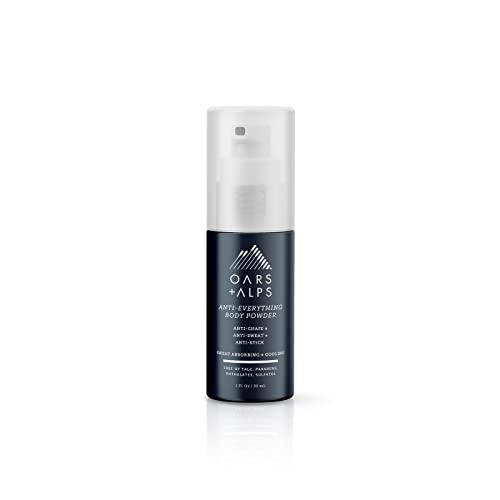
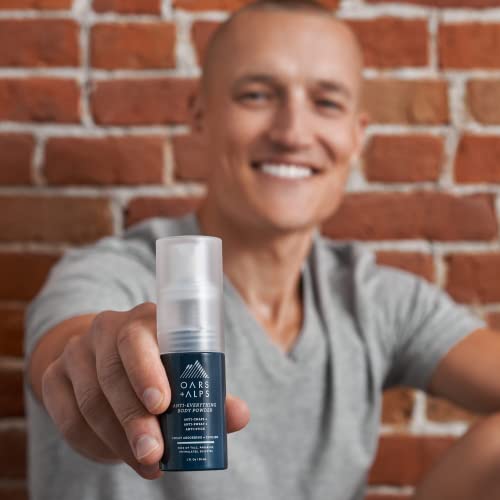

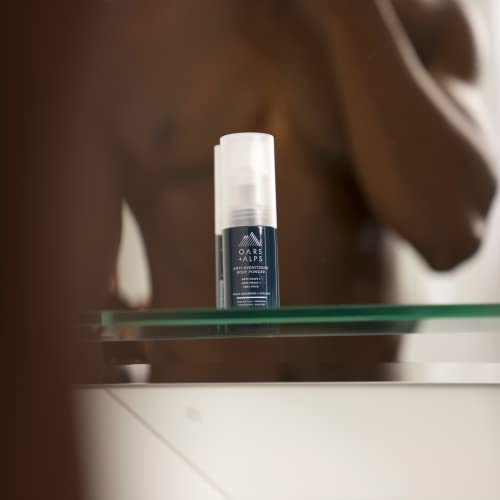
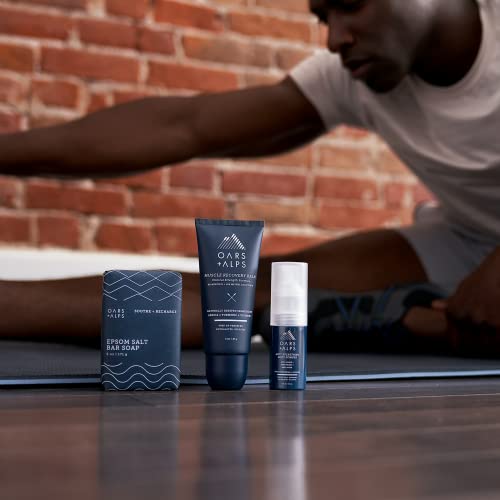


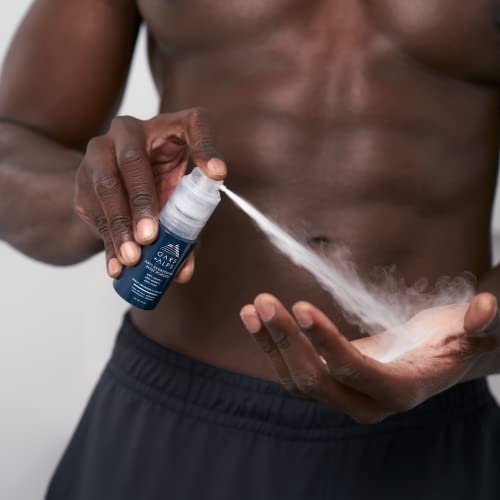
Oars + Alps Body Powder - Sweat Absorbing, Cooling Formula, Aloe & Arrowroot - 1 Fl Oz


Fragrance
High RiskFragrance refers to a mixture of aromatic compounds used in products to provide scent. It is commonly listed as 'fragrance' or 'parfum' on product labels and can serve various functions, including enhancing user experience and masking undesirable odors.
Sustai Insights
Fragrance offers functional benefits by improving product appeal; however, it poses significant health risks, notably a high likelihood of causing allergies and allergic contact dermatitis. Environmental risks include potential pollution and endocrine disruption, though its overall carcinogenicity is low. Regulatory bodies have noted concerns regarding its use, leading to a high-risk classification. Safe usage practices should be observed, and alternatives such as natural essential oils are recommended for those sensitive to synthetic fragrances.
Chlorphenesin
Medium RiskChlorphenesin is a synthetic preservative commonly used in cosmetics and personal care products to prevent microbial growth and extend shelf life.
Sustai Insights
Chlorphenesin serves effectively as a preservative, contributing to product stability. While it poses low to moderate health risks, such as potential irritation and moderate use restrictions, it is not considered a carcinogen. Environmentally, concerns include persistence and bioaccumulation, with regulatory warnings from agencies like Environment Canada and ECHA. Overall, chlorphenesin is assessed as medium risk, highlighting the need for cautious usage and consideration of safer substitutes.
Zinc Oxide(sunscreen Grade)
Medium RiskZinc oxide (sunscreen grade) is a mineral compound often used in sunscreens for its ability to provide broad-spectrum UV protection. It is micronized to improve its cosmetic feel and skin application, making it suitable for various formulations, including those designed for sensitive skin.
Sustai Insights
Zinc oxide offers effective UV protection and is generally considered safe for topical use; however, it has moderate concerns related to allergies and potential skin absorption. Regulatory bodies have noted use restrictions, particularly in specific formulations. While its environmental impact is relatively low, concerns about enhanced skin absorption warrant caution. Overall, the risk level is assessed as medium, and users are advised to follow safe application practices. Alternatives such as titanium dioxide may provide similar benefits with potentially lower allergenic risks.
Mentha Piperita (Peppermint) Oil Extract
Low RiskMentha piperita (peppermint) oil extract is derived from the peppermint plant and is commonly used in various products for its aromatic and flavoring properties. It serves multiple functions, including acting as a fragrance agent and providing a cooling sensation in topical applications.
Sustai Insights
Mentha piperita oil offers functional benefits such as flavor enhancement and a refreshing aroma, while it is generally recognized as low risk for health concerns, including carcinogenicity and allergies. Environmentally, it does not contribute significantly to pollution or bioaccumulation. Regulatory bodies do not impose restrictions on its use. Safe usage practices include avoiding excessive exposure, particularly for sensitive individuals. Alternatives like spearmint oil may be considered, but overall, this ingredient is assessed as low risk.
Sodium Bicarbonate
Low RiskSodium bicarbonate, commonly known as baking soda, is an inorganic compound with the formula NaHCO₃. It functions primarily as a leavening agent in baking, helping to produce carbon dioxide gas when it reacts with acids, thereby causing dough to rise. It also serves as a mild alkaline agent in various personal care products.
Sustai Insights
Sodium bicarbonate is valued for its effectiveness as a leavening agent and its role in neutralizing acidity, contributing to product stability. It is considered environmentally friendly and biodegradable. Health risks are minimal, with low concerns regarding carcinogenicity, allergies, and reproductive toxicity. It is not classified as a pollutant and poses no significant environmental hazards. Regulatory assessments indicate it is safe for use in food and cosmetic products. Overall, sodium bicarbonate carries a low risk, making it a practical choice in many applications.
Cellulose
Low RiskCellulose is a natural polysaccharide derived from plant cell walls, primarily used as a thickening agent, stabilizer, and emulsifier in cosmetic formulations. It is known for its ability to improve texture and consistency in products.
Sustai Insights
Cellulose serves as an effective thickening and stabilizing agent, enhancing product texture while being biodegradable and derived from renewable sources. Health risks are minimal, with low concerns regarding carcinogenicity, allergies, and reproductive toxicity. Environmental impacts are also low, as cellulose does not contribute significantly to pollution or bioaccumulation. Regulatory agencies have not issued restrictions on its use. Overall, cellulose presents a low risk profile, making it a suitable ingredient choice in cosmetics.
Sand
Low RiskSand is loose, granular particles of worn or disintegrated rock, primarily composed of silica. It is commonly used as an abrasive, filler, or in construction and landscaping for its structural properties.
Sustai Insights
Sand offers functional benefits such as providing bulk and texture in various products, and it is generally considered to have low health risks, with minimal concerns regarding carcinogenicity, allergies, or reproductive toxicity. Environmentally, sand does not contribute significantly to pollution and is not bioaccumulative. Regulatory bodies do not impose restrictions on sand usage, maintaining its low-risk status. Safe usage practices should be followed to avoid inhalation of fine particles. Overall, sand is a low-risk ingredient with no notable negative impacts.
Zea Mays (Corn) Starch
Low RiskZea mays (corn) starch is a starch obtained from corn kernels, primarily used as a thickening and stabilizing agent in various cosmetic and food products. It serves as a binder and enhances texture, contributing to the overall formulation's consistency and stability.
Sustai Insights
Zea mays (corn) starch offers functional benefits such as acting as a thickening and stabilizing agent, which helps improve product texture. It is sustainably sourced and biodegradable, posing low health risks, including negligible concerns for carcinogenicity and allergies. Environmental risks are minimal, with no significant pollutant potential noted. Regulatory bodies have not issued advisories, indicating a low overall risk level. Safe usage practices involve ensuring appropriate concentrations in formulations. Alternatives include other plant-based starches or thickeners, which may offer similar functional benefits while maintaining sustainability.
Isopropyl Alcohol
Low RiskIsopropyl alcohol is a common solvent used in various products for its ability to dissolve oils and resins. It is often utilized in cleaning agents, disinfectants, and personal care products due to its evaporative properties and effectiveness in reducing microbial presence.
Sustai Insights
Isopropyl alcohol serves as an effective solvent and disinfectant, contributing to the cleanliness and efficacy of products. It is considered to have low health risks, with minimal concerns regarding carcinogenicity, allergies, or reproductive toxicity. Environmentally, it is not classified as a significant pollutant or bioaccumulative. Regulatory bodies do not impose severe restrictions on its use, classifying it as low risk overall. Safe usage practices should be followed to mitigate any irritation risks, and while alternatives exist, isopropyl alcohol remains a widely accepted ingredient.
Aloe Barbadensis (Aloe Vera) Leaf Extract
Low RiskAloe vera leaf extract is produced from the succulent leaves of the Aloe barbadensis plant. It is commonly used in cosmetic formulations for its moisturizing and soothing properties, making it a popular ingredient in skincare and personal care products.
Sustai Insights
Aloe vera leaf extract offers several functional benefits, including hydration and skin soothing effects, which are well-supported by scientific literature. It is considered to have a low risk for common health concerns such as carcinogenicity, allergies, or reproductive toxicity. Environmentally, it poses minimal risks, with no significant pollutant potential or bioaccumulation reported. Regulatory bodies have not imposed major restrictions, although verified products should not contain certain contaminants. Overall, this ingredient is assessed as low risk, with safe usage practices and the availability of alternative soothing agents if desired.
Mentha Piperita (Peppermint) Oil Extract
Low RiskMentha piperita (peppermint) oil extract is derived from the peppermint plant and is commonly used in various products for its aromatic and flavoring properties. It serves multiple functions, including acting as a fragrance agent and providing a cooling sensation in topical applications.
Sustai Insights
Mentha piperita oil offers functional benefits such as flavor enhancement and a refreshing aroma, while it is generally recognized as low risk for health concerns, including carcinogenicity and allergies. Environmentally, it does not contribute significantly to pollution or bioaccumulation. Regulatory bodies do not impose restrictions on its use. Safe usage practices include avoiding excessive exposure, particularly for sensitive individuals. Alternatives like spearmint oil may be considered, but overall, this ingredient is assessed as low risk.
Sodium Bicarbonate
Low RiskSodium bicarbonate, commonly known as baking soda, is an inorganic compound with the formula NaHCO₃. It functions primarily as a leavening agent in baking, helping to produce carbon dioxide gas when it reacts with acids, thereby causing dough to rise. It also serves as a mild alkaline agent in various personal care products.
Sustai Insights
Sodium bicarbonate is valued for its effectiveness as a leavening agent and its role in neutralizing acidity, contributing to product stability. It is considered environmentally friendly and biodegradable. Health risks are minimal, with low concerns regarding carcinogenicity, allergies, and reproductive toxicity. It is not classified as a pollutant and poses no significant environmental hazards. Regulatory assessments indicate it is safe for use in food and cosmetic products. Overall, sodium bicarbonate carries a low risk, making it a practical choice in many applications.
Cellulose
Low RiskCellulose is a natural polysaccharide derived from plant cell walls, primarily used as a thickening agent, stabilizer, and emulsifier in cosmetic formulations. It is known for its ability to improve texture and consistency in products.
Sustai Insights
Cellulose serves as an effective thickening and stabilizing agent, enhancing product texture while being biodegradable and derived from renewable sources. Health risks are minimal, with low concerns regarding carcinogenicity, allergies, and reproductive toxicity. Environmental impacts are also low, as cellulose does not contribute significantly to pollution or bioaccumulation. Regulatory agencies have not issued restrictions on its use. Overall, cellulose presents a low risk profile, making it a suitable ingredient choice in cosmetics.
Sand
Low RiskSand is loose, granular particles of worn or disintegrated rock, primarily composed of silica. It is commonly used as an abrasive, filler, or in construction and landscaping for its structural properties.
Sustai Insights
Sand offers functional benefits such as providing bulk and texture in various products, and it is generally considered to have low health risks, with minimal concerns regarding carcinogenicity, allergies, or reproductive toxicity. Environmentally, sand does not contribute significantly to pollution and is not bioaccumulative. Regulatory bodies do not impose restrictions on sand usage, maintaining its low-risk status. Safe usage practices should be followed to avoid inhalation of fine particles. Overall, sand is a low-risk ingredient with no notable negative impacts.
Zea Mays (Corn) Starch
Low RiskZea mays (corn) starch is a starch obtained from corn kernels, primarily used as a thickening and stabilizing agent in various cosmetic and food products. It serves as a binder and enhances texture, contributing to the overall formulation's consistency and stability.
Sustai Insights
Zea mays (corn) starch offers functional benefits such as acting as a thickening and stabilizing agent, which helps improve product texture. It is sustainably sourced and biodegradable, posing low health risks, including negligible concerns for carcinogenicity and allergies. Environmental risks are minimal, with no significant pollutant potential noted. Regulatory bodies have not issued advisories, indicating a low overall risk level. Safe usage practices involve ensuring appropriate concentrations in formulations. Alternatives include other plant-based starches or thickeners, which may offer similar functional benefits while maintaining sustainability.
Isopropyl Alcohol
Low RiskIsopropyl alcohol is a common solvent used in various products for its ability to dissolve oils and resins. It is often utilized in cleaning agents, disinfectants, and personal care products due to its evaporative properties and effectiveness in reducing microbial presence.
Sustai Insights
Isopropyl alcohol serves as an effective solvent and disinfectant, contributing to the cleanliness and efficacy of products. It is considered to have low health risks, with minimal concerns regarding carcinogenicity, allergies, or reproductive toxicity. Environmentally, it is not classified as a significant pollutant or bioaccumulative. Regulatory bodies do not impose severe restrictions on its use, classifying it as low risk overall. Safe usage practices should be followed to mitigate any irritation risks, and while alternatives exist, isopropyl alcohol remains a widely accepted ingredient.
Chlorphenesin
Medium RiskChlorphenesin is a synthetic preservative commonly used in cosmetics and personal care products to prevent microbial growth and extend shelf life.
Sustai Insights
Chlorphenesin serves effectively as a preservative, contributing to product stability. While it poses low to moderate health risks, such as potential irritation and moderate use restrictions, it is not considered a carcinogen. Environmentally, concerns include persistence and bioaccumulation, with regulatory warnings from agencies like Environment Canada and ECHA. Overall, chlorphenesin is assessed as medium risk, highlighting the need for cautious usage and consideration of safer substitutes.
Fragrance
High RiskFragrance refers to a mixture of aromatic compounds used in products to provide scent. It is commonly listed as 'fragrance' or 'parfum' on product labels and can serve various functions, including enhancing user experience and masking undesirable odors.
Sustai Insights
Fragrance offers functional benefits by improving product appeal; however, it poses significant health risks, notably a high likelihood of causing allergies and allergic contact dermatitis. Environmental risks include potential pollution and endocrine disruption, though its overall carcinogenicity is low. Regulatory bodies have noted concerns regarding its use, leading to a high-risk classification. Safe usage practices should be observed, and alternatives such as natural essential oils are recommended for those sensitive to synthetic fragrances.
Aloe Barbadensis (Aloe Vera) Leaf Extract
Low RiskAloe vera leaf extract is produced from the succulent leaves of the Aloe barbadensis plant. It is commonly used in cosmetic formulations for its moisturizing and soothing properties, making it a popular ingredient in skincare and personal care products.
Sustai Insights
Aloe vera leaf extract offers several functional benefits, including hydration and skin soothing effects, which are well-supported by scientific literature. It is considered to have a low risk for common health concerns such as carcinogenicity, allergies, or reproductive toxicity. Environmentally, it poses minimal risks, with no significant pollutant potential or bioaccumulation reported. Regulatory bodies have not imposed major restrictions, although verified products should not contain certain contaminants. Overall, this ingredient is assessed as low risk, with safe usage practices and the availability of alternative soothing agents if desired.
Zinc Oxide(sunscreen Grade)
Medium RiskZinc oxide (sunscreen grade) is a mineral compound often used in sunscreens for its ability to provide broad-spectrum UV protection. It is micronized to improve its cosmetic feel and skin application, making it suitable for various formulations, including those designed for sensitive skin.
Sustai Insights
Zinc oxide offers effective UV protection and is generally considered safe for topical use; however, it has moderate concerns related to allergies and potential skin absorption. Regulatory bodies have noted use restrictions, particularly in specific formulations. While its environmental impact is relatively low, concerns about enhanced skin absorption warrant caution. Overall, the risk level is assessed as medium, and users are advised to follow safe application practices. Alternatives such as titanium dioxide may provide similar benefits with potentially lower allergenic risks.
Discover the Oars + Alps Anti-Everything Body Powder for Men, designed to keep you refreshed and dry all day. This talc-free, vegan powder is packed with premium ingredients to combat sweat and chafing, making it perfect for your active lifestyle.
- Natural Moisture Control: Arrowroot powder soothes and deodorizes, providing instant relief from excessive moisture.
- Soothing Hydration: Enriched with aloe leaf juice, known for its anti-inflammatory properties, this body powder helps maintain a refreshed complexion.
- Cooling Sensation: Peppermint oil delivers a natural cooling effect, keeping you feeling fresh wherever the day takes you.
- Eco-Friendly Choice: Gluten and cruelty-free, this formula promotes ethical practices while caring for your skin.
- Versatile Application: Ideal for use on various body areas, from chest to feet, ensuring comfort during workouts or hot weather.
Elevate your personal care routine with Oars + Alps, where wellness meets effectiveness!
Subscribe & Save with Sustai
- Best Price Guarantee: Always enjoy the lowest prices on sustainable home essentials.
- No Surprises: We’ll notify you before shipping. No hidden fees, ever.
- You’re in Charge: Change, pause, or cancel your subscription anytime with ease.
- Eco-Friendly Deliveries: Our grouped shipments mean less packaging and lower emissions.
Join us on a sustainable journey. Special offers for a limited time! Prices and promotions may change.
Recommended Products
Discover the Oars + Alps Anti-Everything Body Powder for Men, designed to keep you refreshed and dry all day. This talc-free, vegan powder is packed with premium ingredients to combat sweat and chafing, making it perfect for your active lifestyle.
- Natural Moisture Control: Arrowroot powder soothes and deodorizes, providing instant relief from excessive moisture.
- Soothing Hydration: Enriched with aloe leaf juice, known for its anti-inflammatory properties, this body powder helps maintain a refreshed complexion.
- Cooling Sensation: Peppermint oil delivers a natural cooling effect, keeping you feeling fresh wherever the day takes you.
- Eco-Friendly Choice: Gluten and cruelty-free, this formula promotes ethical practices while caring for your skin.
- Versatile Application: Ideal for use on various body areas, from chest to feet, ensuring comfort during workouts or hot weather.
Elevate your personal care routine with Oars + Alps, where wellness meets effectiveness!

You can have at most 2 Sustainable Steals products in your cart
Customer Reviews
Customers’ View
Customers appreciate the Oars + Alps Body Powder for its effective sweat absorption and pleasant aroma, noting that it provides a refreshing cooling effect, particularly favored during warm weather. Many users highlight the ease of application, describing the gel-like consistency as user-friendly compared to traditional powders. The product's natural ingredients align well with health-conscious values, being talc-free, vegan, and cruelty-free. However, opinions vary on its value for money, with some customers finding it a bit pricey for the size. Overall, users find the powder beneficial for daily use and travel, contributing to a more comfortable experience throughout the day.
AI-generated from the text of customer reviewsThis product is rated 5.0 of 5.0 stars.
It has received 5 reviews.




